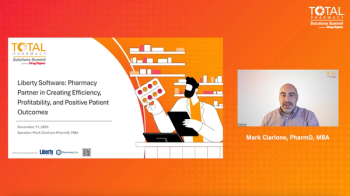
- Total Pharmacy® December 2023
- Volume 01
- Issue 05
How Pharmacists Can Successfully Navigate the FDA’s New DSCSA Stabilization Policy

In August, the FDA issued a 1-year stabilization policy on the final enhanced drug distribution security requirements under the DSCSA. What exactly does that mean for pharmacists?
The Drug Supply Chain Security Act (DSCSA) was set into motion nearly 10 years ago, becoming law on November 27, 2013. The law aims to help the FDA protect consumers from exposure to drugs that may be harmful by improving the detection of potentially dangerous drugs in the US supply chain. The DSCSA outlines steps that manufacturers, wholesalers, and dispensers need to follow to achieve electronic tracing of products at the package level as they are distributed.
Initially, the DSCSA was set to be fully implemented in November 2023, by which time each sector in the supply chain would have had to be fully compliant with federal regulations. But in August of this year, the FDA issued a 1-year stabilization policy on the final enhanced drug distribution security requirements. The stabilization period, which now has a deadline of November 27, 2024, will allow more time to develop the systems and processes necessary for efficient transactions.
During a panel discussion, hosted by the Healthcare Distribution Alliance, at the Total Pharmacy Solutions Summit held on October 28, 2023, Tish Pahl, JD, principal and drug practice head at Olsson Frank Weeda Terman Matz PC, spoke with Elizabeth Gallenagh, JD, general counsel and senior vice president of supply chain integrity at the Healthcare Distribution Alliance, and Scott Mooney, vice president of distribution operations at McKesson, about how pharmacists can navigate the new stabilization policy from the FDA.
“I think it’s important to understand that the FDA…used some terminology that is a little bit different from what we’ve seen in the past on some of their DSCSA pronouncements they’ve made,” Mooney said. “In discussing the compliance policy that the FDA published, the FDA refers to this as a period of time to stabilize and mature DSCSA systems, implying…that you should still be activating your serialized DSCSA processes. But if your serialized DSCSA processes are not 100% perfect or complete, as long as you’re moving ahead and making progress, they seem to be content that that’s enough for the initial phase.”
Although the decision by the FDA has given more time to each sector in the supply chain to be complaint with DSCSA processes, it has left trading partners—including pharmacists—with a lot of questions about what exactly the new stabilization policy means for them.
One of the most important things to note about how the policy will impact the health care supply chain is the parallel approach that will happen over the next year. This approach means that the FDA expects trading partners to continue with their current processes for DSCSA while also beginning to initiate the new serialized traceability requirements. This was one of the major reasons the FDA decided to implement the stabilization period, so that trading partners could implement their processes efficiently.
“The industry wasn’t quite ready for this November, to be honest,” Gallenagh said. “There was a wide variation across sectors, particularly on the manufacturers’ side. We weren’t getting 100% of product aggregated and with the accompanying data that [were] required. All of the testing has not been completed with every single trading partner.… This is a very complex law; nothing like this has ever been accomplished before within this country.... This is something that requires constant communication, constant testing, constant working together across sectors and across the entire supply chain.”
For pharmacists, some of the DSCSA requirements are straightforward, such as buying only from an authorized trading partner, having standard operating procedures in place to identify illegitimate products, and setting aside suspected products until an investigation is complete. However, one challenge could be data management.
Pharmacies will need to have access to DSCSA transaction data and will need be able to share those data with regulators or inspectors in case of an inspection or audit. There are 2 tools pharmacists can use to do this. The first is data portals provided by wholesalers that populate DSCSA data, which customers can use to store data, retrieve them, and export them when they need them. The second tool is third-party solutions that provide services to accumulate data from multiple wholesalers, which accomplishes the same thing as data portals.
In order to be prepared for the DSCSA and to be compliant with the law, it’s crucial that there is constant communication between all supply chain sectors and the FDA to let federal regulators know how things are going and the readiness of the industry. This will ensure that the FDA is aware of how the process is rolling out. It’s also important to ask the FDA for direction, which can be done through larger national trade associations.
“I think those associations are going to be working together to both communicate to FDA and [Capitol] Hill about how things are happening and what the state of the industry is,” Gallenagh said. “I would say don’t let your foot off the gas in terms of providing information, whether it’s to your trading partners or whether it’s to your trade associations, and communicating with the FDA.”
Articles in this issue
almost 2 years ago
NCPA Pharmacy Ownership Workshop Empowers, Educates, and Inspiresalmost 2 years ago
Understanding the Foundations of Pharmacy Financial Healthabout 2 years ago
Implementing Technological Workflow May Usher in New Era of Pharmacyabout 2 years ago
Opportunities Abound to Take Back Your PharmacyNewsletter
Pharmacy practice is always changing. Stay ahead of the curve with the Drug Topics newsletter and get the latest drug information, industry trends, and patient care tips.











































































































































































































